7 Minutes
The Birth of a Drag Racing Icon: 1968 Hemi Cuda Prototype
Where Chrysler’s Super Stock Domination Began
Every car enthusiast knows the Plymouth Hemi Cuda is a legend, but few realize the story of the very first factory Super Stock Hemi Cuda started with just a one-dollar bill. Official records trace the debut of the Hemicuda to 1970, but the real genesis—an engineering marvel created for the drag strip—rolled out two years earlier as a raw prototype, the 1968 Plymouth Barracuda B029, also known as "the Mule."
The E-Body Revolution and the Prototype’s Secret Origins
Building a Racing Platform for All Engines
In the late 1960s, Chrysler set out to rewrite performance car history. The all-new E-body platform was engineered to fit everything from the economical Slant Six to the thunderous 426 cubic-inch Hemi V8. But before the production Hemicuda became a reality, Chrysler’s Special Vehicle Department began experimenting in secrecy. They took a humble 340ci Formula S Fastback and, under the guidance of Chrysler engineer Tom Hoover, assigned young innovator Bob Tarozzi a singular mission: shoehorn the massive 426 Hemi into the Barracuda chassis and transform it into the ultimate drag strip weapon.
Engineering Excellence: Tarozzi’s Lab Car
Under Bob Tarozzi, every aspect of the prototype was diligently reimagined. From magnesium front wheels to custom flexible brake-line adapters designed to clear the wide Hemi valve covers, Tarozzi ensured this mule was as light, balanced, and race-ready as possible. In true hot-rodder spirit, he emblazoned its decklid with “Nobody Cares,” reflecting the skepticism he faced—and later disproved—within Chrysler and the racing community. Even racing legends like Ronnie Sox had doubts, but when tested, "the Mule" delivered unmatched balance and performance on the track.
From Crusher to Drag Strip: The $1 Miracle
An Historic Save by Arlen Vanke
Once Chrysler extracted all its test data from the car, the prototype was bound for destruction. Saved by the quick thinking of drag racing ace Arlen Vanke—who purchased it for just $1 (about nine bucks today adjusted for inflation)—the Mule found a second life as the “Suppa Cuda.” Vanke dropped in his hand-built Hemi engine, handed the keys to driver Tony Suppa, and nearly claimed NHRA glory, falling just short of a win at Indianapolis.

A Legacy of Provenance: Restoration and Preservation
Later, renowned collector Pat McGroder meticulously restored the car to exact Irwindale specs, with Bob Tarozzi himself authenticating each original part. Collector Myron Serbay eventually took over stewardship, displaying the Mule at prestigious events like the All Hemi Reunion, the Chrysler Museum in Auburn Hills, and the iconic 2024 Sox & Martin Hemi Challenge at Indy. Even modern champions acknowledge this historic Cuda as the cornerstone of Chrysler’s Super Stock success.
Core Specifications: A Purpose-Built Dragster
Engine, Drivetrain, and Performance
At its heart, the 1968 Hemi Cuda prototype boasts a hand-assembled 426ci Hemi V8 with cross-ram intake, dual Holley four-barrel carburetors, and a 12.5:1 compression ratio—the same aggressive setup Arlen Vanke perfected. The drivetrain pairs that raw power with a TorqueFlite A727 automatic transmission, race-tuned Dana 60 Sure Grip rear end, Super Stock leaf springs, lightweight six-cylinder torsion bars up front, and bespoke steering and master cylinder assemblies.
Stripped for Speed: Weight Reduction and Race Equipment
Every removable ounce was sacrificed in pursuit of speed: no carpets, using acid-dipped steel doors, a fiberglass front clip, pull-strap plexi windows, and featherweight racing seats. While the rear wheels remain chromed steel for durability, the fronts run ultra-lightweight magnesium, all rolling on period-correct racing slicks. This strategy of purposeful engineering established a template every subsequent Super Stock Barracuda would follow.
The Benchmark: Provenance, Rarity, and Racing Dominance
Fifty Racing Legends—One Prototype
Hurst Performance built only about 50 B029 Super Stock Barracudas in 1968, each meticulously prepared for NHRA Super Stock/A-Hemi (SS/AH) competition. But “the Mule” stood out as the original testbed, the prototype that proved the formula. Its engineering and track exploits were meticulously documented by Chrysler, later immortalized in Hot Rod Magazine and legendary photographic spreads.
Factory Race Car Credentials
The factory offered no warranty or luxury—just pure racing intent. Stripped interiors, twin bucket racing seats, spartan dash clusters, relocated battery, and a lightweight, narrowed front end reflected a singular focus: 1,320-foot domination. Chrysler even explicitly warned these were “not built for highway or passenger use”—only the brave and skilled needed to apply.
Market Value: From $1 to Seven Figures
Auction Drama: The Market Struggles with History
Despite its unique provenance, the Mule’s journey through the modern collector car market has been turbulent. When the 7,290-mile prototype crossed the block at Mecum Indy 2025, bidding stalled at $125,000—not even meeting the reserve. An incredible piece of drag racing DNA, a car that helped shape Chrysler’s racing blueprint and survived the crusher, barely breached six figures before the auctioneer’s gavel fell.
Current Valuation: Seven Figures for a One-of-a-Kind Super Stock
Today, the asking price for the prototype sits at an astonishing $2 million—a far cry from its original one-dollar "adoption fee." This dramatic leap in value reflects not just rarity, but the deep historic impact. Unlike replicas or tributes, this car is the foundation of the Hemi Super Stock era—a true piece of automotive history.
How the 1968 Hemi Cuda Compares
Legacy Against Modern Muscle and Other Legends
While modern muscle cars like the Dodge Challenger SRT and Ford Mustang Shelby GT500 pack in advanced technology and stratospheric horsepower, few vehicles offer the same raw, visceral blueprint as the 1968 Super Stock Barracuda. The prototype was never built for comfort or road use. It was engineered with ruthless efficiency—fiberglass hoods, acid-dipped metalwork, and magnesium wheels—unmatched by contemporaries such as the Yenko Camaro or COPO Chevelle, and distinctly pure compared to today’s luxury-laden, high-tech supercars.
Continuing Influence
The influence of the original Mule extends beyond its era. Every modern drag racing Mopar, from Hemi-powered Challengers to niche Dodge COPO competitors, owes some of its DNA to the innovation, daring, and unfiltered engineering of this first Barracuda prototype. Without the Mule, Chrysler’s racing legacy would not be what it is today.
Design and Construction: Purpose-Driven Engineering
From Drag Strip to Blueprint
The bodywork, sporting “Woodward Garage” etching, signaled its prototype heritage. Inside, stripped-down functionalism ruled: just two racing buckets, a Jones tach and Stewart-Warner gauges, and bare essentials. Even bolt patterns were narrowed to accommodate lighter racing wheels, and the trunk resembled a fighter jet hatch more than a commuter car. Chrysler, knowing the risks, boldly reminded buyers: these cars were never intended for public roads.
Technological Brilliance in Simplicity
The car’s unorthodox tech—like relocating batteries, acid-dipping panels, and custom chassis tweaks—showcased creative problem-solving that would become the hallmark of factory drag racing specials.
Mopar Mythology: Why the Mule Still Matters
The Cornerstone of Muscle Car History
Surviving not just the passage of time, but also countless dragstrip battles and the threat of the crusher, the Mule stands as the essential prototype, the first draft of Chrysler’s greatest drag racer. Today it remains uncompromising—its original nobody-cares bravado replaced with universal recognition among the most hardcore Mopar fans and automotive historians.
Fate Awaits: The Next Chapter?
If a true aficionado steps up, the story of the 1968 Hemi Cuda prototype, the legendary Mule, will enter its next act. If not, it risks retreating back into storage while the market gradually wakes up to its immense significance. This car isn’t just rare—it is foundational. It’s Mopar mythology incarnate: forged in blueprints, steel, fiberglass, fuel, and fire. For anyone passionate about automotive culture, factory drag racing, and muscle car history, this is the ultimate holy grail—daring someone to keep the legend alive.
Source: autoevolution



Comments